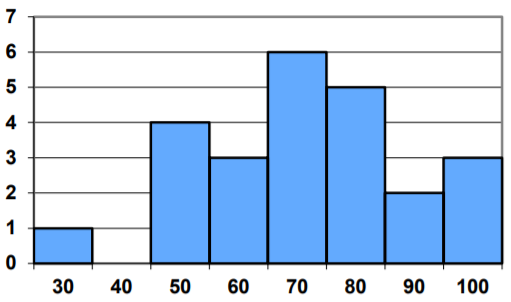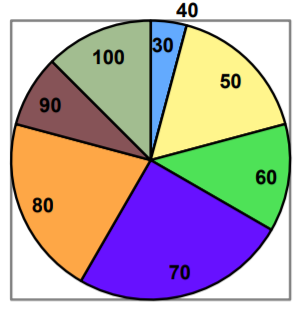12.9: Capítulo 9 Soluciones para ejercicios
- Page ID
- 112974
Capítulo 9: Estadística, Describiendo Datos.
1. a. Diferentes tablas son posibles
| Score | Frecuencia |
| 30 | 1 |
| 40 | 0 |
| 50 | 4 |
| 60 | 3 |
| 70 | 6 |
| 80 | 5 |
| 90 | 2 |
| 100 | 3 |
b. Esto es técnicamente un gráfico de barras, no un histograma:

c.
3. a.\(5+3+4+2+1 = 15\)
b.\(\dfrac{5}{15} = 0.3333 = 33.33 \%\)
5. Bar está en\(25 \%\). \(25 \%\)de\(20 = 5\) los estudiantes obtuvieron una A
7. a.\(\dfrac{(7.25+8.25+9.00+8.00+7.25+7.50+8.00+7.00)}{8} = $7.781\)
b. En orden,\(7.50\) y\(8.00\) se encuentran en posiciones medias. Mediana\(= $7.75\)
\(0.25 \times 8 = 2\)c. Q1 es el promedio de\(2^{\text{nd}}\) y\(3^{\text{rd}}\) los valores de datos:\($7.375\)
\(0.75 \times 8 = 6\). Q3 es el promedio de\(6^{\text{th}}\) y\(7^{\text{th}}\) los valores de los datos:\($8.125\)
Resumen de 5 números:\($7.00, $7.375, $7.75, $8.125, $9.00\)
9. a.\(\dfrac{((5 \times 0) + (3 \times 1) + (4 \times 2) + (2 \times 3) + (1 \times 5))}{15} = 1.4667\)
b. La mediana es el valor\(8^{\text{th}}\) de los datos:\(1\) child
\(0.25 \times 15 = 3.75\)c. Q1 es el valor\(4^{\text{th}}\) de los datos:\(0\) niños
\(0.75 \times 15 = 11.25\). Q3 es el valor\(12^{\text{th}}\) de los datos:\(2\) niños
Resumen de 5 números:\(0, 0, 1, 2, 5\)
d.
11. Kendra hace\($90,000\). Kelsey hace\($40,000\). Kendra hace\($50,000\) más.


